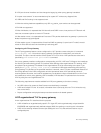
You can use the version both command in INTERFACE mode to migrate from VRRPv2 to VRRPv3. When
you set the VRRP version to both, the switch sends only VRRPv3 advertisements but can receive VRRPv2
or VRRPv3 packets.
To migrate an IPv4 VRRP group from VRRPv2 to VRRPv3:
1. Set the switches with the lowest priority to “both”.
2. Set the switch with the highest priority to version to 3.
3. Set all the switches from both to version 3.
NOTE: Do not run VRRP version 2 and version 3 in the same group for an extended period of time
Example: Migrating an IPv4 VRRP Group from VRRPv2 to VRRPv3
NOTE: Carefully following this procedure, otherwise you might introduce dual master switches
issues.
To migrate an IPv4 VRRP Group from VRRPv2 to VRRPv3:
1. Set the backup switches to VRRP version to both.
Dell_backup_switch1(conf-if-te-0/1-vrid-100)#version both
Dell_backup_switch2(conf-if-te-0/2-vrid-100)#version both
2. Set the master switch to VRRP protocol version 3.
Dell_master_switch(conf-if-te-0/1-vrid-100)#version 3
3. Set the backup switches to version 3.
Dell_backup_switch1(conf-if-te-0/1-vrid-100)#version 3
Dell_backup_switch2(conf-if-te-0/2-vrid-100)#version 3
Assign Virtual IP addresses
Virtual routers contain virtual IP addresses configured for that VRRP group (VRID). A VRRP group does not
transmit VRRP packets until you assign the Virtual IP address to the VRRP group.
For more information, refer to VRRP Implementation.
To activate a VRRP group on an interface (so that VRRP group starts transmitting VRRP packets),
configure at least one virtual IP address in a VRRP group. The virtual IP address is the IP address of the
virtual router and does not require the IP address mask.
You can configure up to 12 virtual IP addresses on a single VRRP group (VRID).
The following rules apply to virtual IP addresses:
• The virtual IP addresses must be in the same subnet as the primary or secondary IP addresses
configured on the interface. Though a single VRRP group can contain virtual IP addresses belonging
to multiple IP subnets configured on the interface, Dell Networking recommends configuring virtual
IP addresses belonging to the same IP subnet for any one VRRP group.
– For example, an interface (on which you enable VRRP) contains a primary IP address of 50.1.1.1/24
and a secondary IP address of 60.1.1.1/24. The VRRP group (VRID 1) must contain virtual addresses
belonging to either subnet 50.1.1.0/24 or subnet 60.1.1.0/24, but not from both subnets (though
the system allows the same).
• If the virtual IP address and the interface’s primary/secondary IP address are the same, the priority on
that VRRP group MUST be set to 255. The interface then becomes the OWNER router of the VRRP
1004
Virtual Router Redundancy Protocol (VRRP)


















